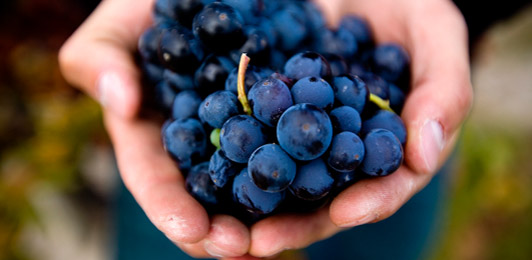Winemaking

Good wine is made from balanced, well-flavored grapes, so we painstakingly nurture our estate grapevines all year and also strive to obtain the best fruit from other maritime influenced vineyards. (See Vineyards)
Harvest dates vary between vineyards and varieties and are different every year, depending on the weather. The grapes must be ready. We taste them and test them and when they reach the right balance of sugar, acidity and flavor, we “call the pick” or bring the fruit in to be crushed.
Everything in the wine comes from the grapes and the terroir where they are grown. Our winemaking philosophy is to maintain the integrity of the grapes and try to express their innate characteristics in the wine.
The Blend of Art and Science
We want whole, undamaged grapes without bruised or broken skins, because healthy, unblemished fruit ferments cleanly and makes for better tasting wine. Our grapes are carefully handpicked and sorted gently (we do not use mechanical harvesters).
We hand-harvest our grapes during the night or at dawn because the temperature is coolest then. Keeping the grapes cool prevents spoilage and improves fermentation quality. At the winery we hand sort them again to remove damaged fruit and any other matter (leaves, bugs, twigs etc.).
Our wines are crafted in small batches. This allows us to use artisan winemaking techniques that enhance fruit character but are not feasible in large scale production.
We generally use the flavor enhancing technique of “cold-soaking” (cold maceration) for a few days before the grapes are transferred to a fermentation tank.
To preserve more of the local character and unique flavor of the terroir, we often choose to ferment with indigenous wild yeasts.
Small lot production helps us to minimize processes that can diminish the flavor or aroma of the wine, such as heavy use of sulfur dioxide, filtering and mechanical pumping.
Another reason we choose to produce in small lots is to keep individual blocks of grapes separated through the fermentation process. Each lot retains the flavor of the grapes that went into it. This gives us a “palette” of many unique “colors” to choose from for our Deep Sea blends or small volume varietals.
Harvest time is hectic as new grapes arrive at the winery every day and must be attended to immediately. It is reassuring for the winemakers to know that while they are busy tending to the new arrivals, the established fermentations are proceeding properly and gentle punch-downs are performed automatically exactly on schedule. Our state-of-the-art equipment allows them to have their hands busy with one lot, and not worry that another lot needs immediate attention.
All of our red wines and some of our whites are aged in oak. We use mostly French oak barrels (très cher) and the occasional American oak, with varying degrees of barrel toasting.
A further advantage of multiple small lot production is the ability to do controlled experiments with side-by-side comparisons. (We like to tinker.) We continually experiment, evaluate and fine tune our processes from vineyard to barrel to bottle.
So while our wine is really good now, future vintages will be even better.
Questions? Email Gillian@conwayfamilywines.com.
As grapes approach ripeness, sugar content increases, acidity decreases and flavor develops. Our grapes are repeatedly tested in the enology lab and tasted by the winemakers. As soon as they reach the right balance of sugar, acidity and flavor we harvest them.
Cold maceration, or “cold-soaking” of whole (usually red) grapes improves the extraction of desirable flavors and pigments from the skins. During this process the indigenous wild yeasts found naturally on the grape skins begin to multiply, while natural enzymes inside the grape begin the conversion of sugar to alcohol.
The French word terroir signifies the unique environmental influences of a place that affect its grapes such that wine made from them is different and distinct from wine made from similar grapes elsewhere. Local climate, topography, soil and vineyard practices are all significant factors.
Indigenous wild yeasts, sometimes called “native” or “natural” yeasts, occur naturally in the vineyards and are found on the skins of ripe grapes. Some winemakers (like us) prefer to ferment as far as possible with the wild yeasts, only introducing a commercial yeast if necessary to complete the fermentation. This provides a greater variety of flavors and preserves more of the character of the individual terroir. It is risky however, for wild yeasts can be unpredictable and if something goes amiss the entire batch is lost. In typical commercial wine production the wild yeasts are killed with sulfur dioxide before inoculation with a commercial yeast.
During fermentation bubbles of carbon dioxide are formed and rise to the top of the tank. The bubbles carry grapes and skins to the top of the tank, forming a layer or “cap” floating on top of the liquid. This cap must be periodically broken up and stirred back into the liquid to maintain even concentrations. One punch-down method is to manually break up the cap and stir the tank with large paddles. Another approach (pumpover) is to mechanically pump liquid from the bottom of the tank to pour over the top of the cap. We use a computer controlled mechanical punch-down system that performs gentle punch-downs at the desired intervals.
